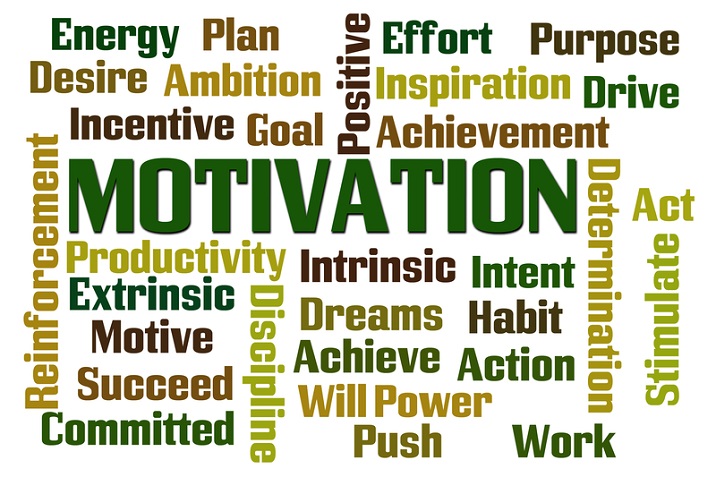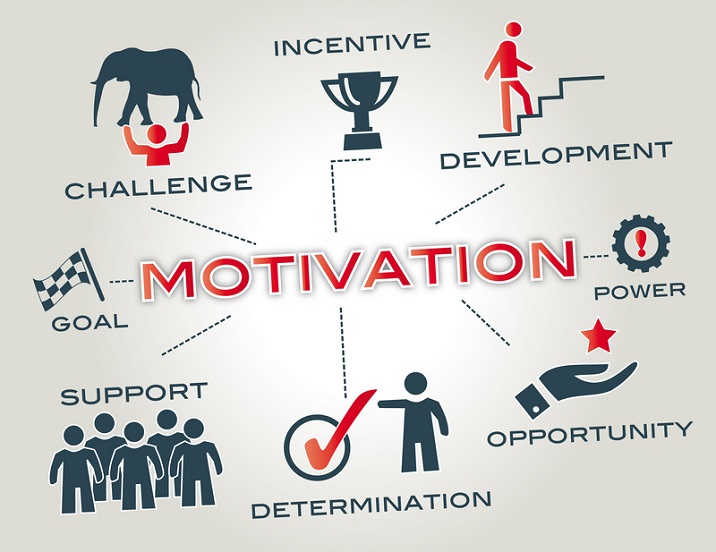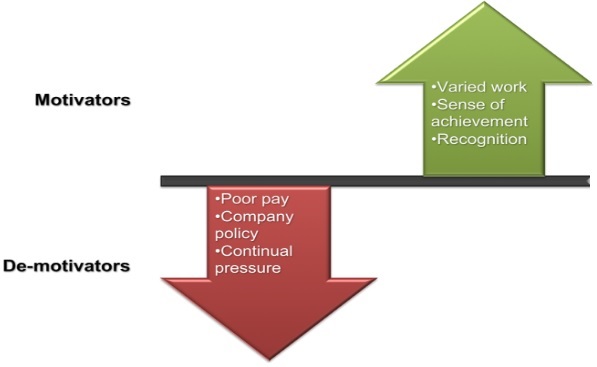
- Employee Motivation - Home
- Employee Motivation - Introduction
- Motivating Factors
- Employee Motivation - Tips
- Employee Motivation - Importance
- Psychological Approach
- Maslow's Hierarchy of Needs
- Herzberg's Theory
- Object Oriented Theory
- Reinforcement Theory
- Behavior Modifications
- Expectancy Theory
- Employee Motivation - Setting Goals
- SMART Goals Setting
- Personality Trait Theory
- Employee Motivation - On the Job
- Employee Motivation - Key Factors
- Self-Motivation
Employee Motivation - Quick Guide
Employee Motivation - Introduction
Employee Motivation is an integral part Human Resource Management and it plays a crucial role in the long-term growth of an organization. Motivation can be defined as the inherent enthusiasm and driving force to accomplish a task. It can be used in directing employees behavior and actions for a constructive vision or goal. Proper motivation turns an employee into a loyal asset and helps in maintaining the retention rate.
What is Employee Motivation?
The word motivation is derived from Latin word movere which means to move. Motivation is something a desire, a want, need or drive − that moves or spurs an individual to act in a particular way to achieve a goal or objective.

The factors that stimulate the behavior and actions of the people are as follows −
- Success and advancement in Life
- Desire for Money
- Desire to be empowered
- Work Satisfaction
- Recognition in the Society etc.
Employee motivation is defined as the commitment, the energy levels, and the creativity that the employees bring to their job. Even though employees motivation doesnt directly influence organizations growth, it is like a necessary pre-condition because lack of motivation among the employees can have a detrimental effect on their performance.
Impact of Well-Motivated Employees
Well-motivated employees are an asset to the organization and they write the success of organization and therefore, every organization should accord utmost attention to employees motivation.
A well-motivated employee stays with the organization through its thick and thin. Motivation is essential for establishing an effective relationship between the employer and the employees.
In the modern management system many methods of motivation have been put into practice to enhance productivity of the employees. Apart from various methods of motivation, there are certain well-acknowledged motivators such as job design, nature of job and system of incentives and rewards for the employees that play a decisive role in ensuring employees longevity, productivity and efficiency.
Employee Motivation - Motivating Factors
Motivation is integral to employees performance in particular and the growth of the organization in general. However, the most important question needs to be answered is how to motivate an employee?
Human behavior is quite complex to understand. Before knowing how to motivate employees, it is essential to know what motivates them. Employees are motivated by both financial and non-financial motivators.

Financial Motivators
The motivators related to money are called financial motivators. Regular and good wages and salary, bonus, periodical increments, profit sharing, leave with pay, medical reimbursements are some of the common financial motivators. Lack of these motivators has a negative bearing upon the performance of the employees.
Non-Financial Motivators
Certain motivators that are not related to money but have a positive impact on the employees are called non-financial motivators. Some of the non-financial motivators are as follows.
- Job Security
- Performance Appraisal, praise and prestige
- Delegation of authority
- Congenial work environment
- Status and pride
- Participation
- Job enrichment
- Job rotation
- Facilities for paid leaves
- Quality of work life
There are many ways to motivate an employee, but choosing the right way to motivate is the difficult task. Considering the complexity and volatility of human behavior, it is pertinent to study the behavior of the employees who need to be motivated.
Any organization is built with employees; hence, employees are called as the building blocks of any organization. Success of any organization is in the hands of the employee and their collective efforts. Employees contribute their work and skills collectively to the organization for its growth, only when they are motivated.
Employee Motivation - Tips
Every organization needs employees who work dedicatedly and sincerely. And making an employee to do his job, salary is not the only criteria, motivation also plays a major role in this scenario.
Following are some of the useful tips as to how to motivate the employees −
Self-Evaluation
Managers need to evaluate their own behaviors, attitudes and approaches towards their employees. Employee-friendly behavior and attitudes help the managers in motivating, controlling and encouraging the employees.
Familiarity with the Employees
As the manager and the employees together work towards achieving the organizational goals, the former needs to nurture some familiarity with the latter. It is the responsibility of the manager to be acquainted with his/her employees for knowing them better and maintaining a constructive and cordial relationship. A work environment built on mutual trust and cooperation between the managers and the employees brings in development and growth of the organization.

Employee Benefits
Monetary and non-monetary benefits are the most important means of motivating employees. Hence, financial benefits like good salary, periodical increments, facilities for insurance and medical reimbursement and non-financial motivators like job security, a congenial work environment etc. go a long way in motivating the employees. The management should make possible arrangements for availing these benefits for effective employees motivation.
Introducing New Employees
New employees should be introduced in such a manner that they will find themselves comfortable and assured in the new work environment. It will motivate them to work with energy and drive them towards realizing the organizational goals.
Feedback to Employees
Feedback is an important tool to motivate employees. Giving feedback to employees endows them with an ability to gauge their own performances. This helps in also appreciation and improvisation. However, feedback should be properly worded, taskfocused and to the point so as not to create a sense of inferior complexity in the employees.
The person giving feedback is, in most cases, is superior to the receiver. Friendly and positive feedback proves healthy for both manager-employees relationship and growth of the organization.
Timely Appreciation
Recognizing the performance of the employees and praising them for their good acts in time motivates them. Lack of appreciation of employees performance decelerates the pace of work in an organization. A pat on the back of any employee for his good work or achievement, makes him/her motivated and this helps in giving better outputs.
Time Management
Maintaining time is very important and having a control over the time, will make the work to be done in time and that too in a right manner.
Pleasant Work Environment
A friendly and comfortable work environment not only attracts the employees to the workplace but also make them eager to work efficiently. Free space, good lighting system, equable temperature inside the workplace etc. have a positive impact on employees performance. A stress-laden work atmosphere dampens the spirit of the employees and they perform below expectation.
Employee Learning
Every employee should be given an opportunity to learn new things, which helps in the growth of the individual in them as well the organization.
Empowering the Employees
Employees should be given an opportunity to have a say in how they do their job, how they can improve their performance. If possible, employees should be asked individually as to how they view themselves and can be more efficient. However, employees advice in this regard needs to be implemented to give them a sense of empowerment. Certain amount of decision making in performing their job is also quite encouraging for the employees.
Effective Communication
Communication plays an important role in smooth functioning of an organization. An effective communication clears many problems and builds a trust among the employee with transparency. Face-to-face communication with the employees is more effective than other means of communicating and it truly motivates them a lot.
Managers Should be Leaders
By expertise, knowledge and effective managerial qualities, managers should present themselves as leaders worth following. Recognizing the performance of the employees and praising them for their good acts in time motivates them. Lack of appreciation of employees performance decelerates the pace of work in an organization.
Employee Motivation - Importance
By now it is understood that, employees are pivotal to the evolution and growth of an organization and play an important role in achieving the goals and objectives of the organization.
The importance of motivating employees is second to none in an organization. Employees motivation is quite useful and beneficial in a number of ways for the organization. The importance and the benefits of Employee Motivation is as follows −
Role of Human Resource
An organization is essentially built upon three basic edifices like physical, financial and human resources. Motivating the employees, who constitute the human resource of an organization, is essential for effective functioning of the organization.
Increase Efficiency
Proper and timely motivation of employees help increase the productivity and efficiency of employees. When employees are motivated they bring energy and speed to the functioning of an organization constitutes motivation in employees can lead to −
- Increase in Production
- Reduction in cost of operations
- Improvising the overall efficiency
Organization Goal Achievement
Motivation is the important factor for achieving the organizational goals. This goals can be achieved with the following factors −
Effective and efficient utilization of resources
Congenial and better work environment with better cooperation among the employees while working towards realizing organizational goals
Employee are to be objective oriented in achieving goals
Good coordination the employees and the management
Enduring Relationship
When employees are highly motivated they show a great deal of satisfaction in working for the organization. The management or the employees should attempt to strike a cordial relationship with the employees by providing certain possible financial and nonfinancial motivators as discussed above.
Workforce Stability
Workplace and workforce stability is very important aspect of any organization. It will project the goodwill and the reputation of the organization. Being loyal to the organization and utilizing the skills and being efficient towards their respective work the employees can write success after success for the organization they work for. Hence, employee motivation is very important.
Mick Mount and Ning Li, management and organization professors, said if an employee is an ambitious, go-getting extrovert whose high-order goal in life is status, then it will be hard for an employer to motivate the employee, if he or she works in a repetitive job with no advancement opportunity.
On the contrary, they said in case an employee is a shy, retiring type who wants autonomy, he or she will not be motivated to better performance only by promising a promotion because the last thing he or she wants is he/she doesnt like to be in charge of other people.
"The implication for businesses, then, is that we first need to understand which goals matter to employees and then match those goals to characteristics of jobs so we can make work more meaningful and intrinsically motivating to the person," Mount said.
Psychological Approach
Motivation is a process of energizing and developing interest among the employees, who, when motivated move at a good pace towards achieving the goal of an organization. It influences employees behavior and the ways they react to different situations. Hence, methods of motivation changes from time to time with different people, environment and situations etc.
Its well-acknowledged that motivation brings in a lot of benefits to an organization. However, getting motivated and making others motivated is the challenging task. During the past several years behavioral and social scientists have made in-depth research and study to find out suitable motivation techniques. They studied what motivates the behavior of a person, how and why?

In the modern management era, many theories have been suggested by behavioral scientists for effective motivation of employees with a view to increasing production and ensuring progress of the organization.
Some of the important modern theories of motivation like Maslows Hierarchy Theory and Herzbergs Two-factor theory have considerably influenced the ways the employees of modern organization are motivated.
In the next two chapters, we will discuss these two popular theories of motivation.
Maslow's Hierarchy of Needs
Abraham Maslows widely acknowledged need hierarchy theory evolved in 1940s hold good even today for having a good understanding of human motivation. The theory has tremendous effect on modern management approach to motivation. Basing upon his experience on human behavior, Maslow came to the conclusion that a persons motivational needs can be put in a hierarchical order.
Maslow found five levels in his need hierarchy. They, from bottom to top are as follows −
Physiological Needs
Basic needs like hunger, thirst, sleep need primary attention while motivating employees. These needs once fulfilled no longer motivate. However, existence of these needs largely hampers employees performance.
Safety Needs
It is human nature to feel safe and secure everywhere. Maslow emphasized emotional and physical safety. Fear of losing job, property, shelter etc. demotivates the employees. These are related to physiological needs.
Social Needs
Man is a social animal. As he starts living healthy, safe and secure, he seeks love, friendship, affection and belongingness from other human beings like his kith and kin. These needs motivate the employees behavior to a great extent at both conscious and sub-conscious levels.
Esteem Needs
Esteem-related needs belong to the highest order needs. Human beings strongly want for power, authority, achievement and high status that give him reputation and esteems in the society.
Self-actualization Needs
It is the higher order need in Maslows need hierarchy. It is a desire to become what one wants in life. The need to lead a meaningful and satiated life belongs to this level. A sense of self-fulfillment motivates a person to do higher achievements.
Employee Motivation - Herzberg's Theory
Frederick Herzbergs Theory of Motivation is commonly based upon two important factors of motivation such as Hygiene Factors and Motivation Factors. Hence, Herzbergs theory evolved in 1950s, is otherwise called Two Factor Theory of Motivation. It brings considerable modification in Maslows need hierarchy.
The Foreground of Two Factor Theory of Herzberg
Herzberg undertook an interview with about two-hundred engineers and accountants representing a cross section of Pittsberg Industry to discover important factors that motivate them the most. He enquired them of such events at work place which had either increased or reduced their job satisfaction.
Upon the basis of the extensive interview Herzberg found two set of factors that motivate employees. The first set called satisfiers are motivators or growth factors and the second set called dissatisfiers are related to hygiene or maintenance factors.
| Herzbergs Two Factor Theory | |
| Hygiene or Maintenance Factors | Motivation Factors |
|
|
Hygiene Factors
Hygiene factors are related to aspects of external environment an employee or employees interact with. The hygiene factors listed above shows mans relationship to the context or environment in which he does his job. These factors are, therefore, related to the immediate surrounding or peripheral aspects of the job, thus, extrinsic to the job.
Hygiene factors dont necessarily motivate employees in an organization to a better performance; yet these factors cause dissatisfaction with their absence while their presence doesnt bring satisfaction. Hence, these factors are named by Herzberg as dissatisfiers. They breed dissatisfaction with their absence while their presence does not bring satisfaction.
Hygiene factors are preventive rather curative. For instance, lack of interpersonal relationship among the employees causes dissatisfaction among the employees but good interpersonal relationship among them slightly motivate them to better performance and effort.
Motivational Factors
Herzbergs second group of factors is a set of real motivators or job content factors. Herzberg found these factors to be real motivators because they have the potential of yielding a sense of contentment or satisfaction. Motivating factors are related to the nature of work and are thus intrinsic to the job itself. They are quite helpful in motivating the employees to higher or superior performance and effort.
Existence of motivators like recognition of jobs and prospects for growth in job prove highly motivating for the employees. Lack of these motivators doesnt cause dissatisfaction while their presence brings satisfaction.
In essence, the factors that ascertain how an employee feels about his job are motivational factors, the variables that influence how an employee feels about his organization is environmental or hygiene factors. Adequate presence of hygienic factors is essential for attracting employees to an organization.
Based upon these factors, Herzberg concluded that people feel motivated if the job is promising and challenging; if there is a prospect of growth exists in it; if they have responsibility and authority to use their mite and discretion in the job. To this effect, Herzberg suggested job enrichment instead of job enlargement as a viable strategy for motivation.
Herzbergs focus on the significance of job content is a substantial contribution to employees motivation. However, Herzbergs Two Factor Theory has been criticized for its original research evidence was confined only to 200 workers and he did not establish any cause and effect relationship between satisfaction and performance.
Object Oriented Theory
Motivation in an Employee is the internal factor, which drives him/her for accomplishing the activities which are related to work in the organization. It drives the employee in taking action and making a decision, as to what to do and what not to do?
Everyone needs motivation to achieve something or to put his/her best effort to realize a goal. But, a real winner needs a positive attitude over and above motivation and penchant for winning. A positive attitude enables a person to move towards realizing the desired goal.
Different people with differing mindsets behave differently in different situations, be it in organization or in the society. Many people are quite objective in their approach to any work. They work better, when they have some concrete facts in front of them i.e., what to do and what not to do. Upon this basis the object-oriented theory of motivation thrives.
The Object-Oriented Theory of Motivation describes about the three theories of motivation, which are as follows −
- The Carrot
- The Whip
- The Plant
The aforesaid three methods of motivation are applicable to different people in an organization with different mindsets and expectations.
An employee is motivated when he/she finds his/her needs met and interests fulfilled. If his immediate needs are not met, he is not at all motivated and the motivation is found ineffective. Hence, choosing an appropriate method of motivating a particular employee or group of employees is an onerous task itself.
The Carrot
In the middle of 20th century, the carrot method of motivation was the idea of a cart driver, where he/she would tie a carrot to along stick and dangle it in front of the donkey or horse which pulls his/her cart. As the horse/donkey moves forward towards the carrot, the cart gets pulled and moves forward. This continues, till the cart driver reaches his destination.
Here, the Carrot was given as a reward for encouraging the Horse/Donkey to pull the cart in reaching his/her destination. Carrot is modern day organization may be certain financial or non-financial rewards that spurs employee/s to work with an increasing pace to give better performance. T Provisions for paid leaves, safe and flexible work environment energizes the employees to give their best to the organization.
The Carrot theory talks about motivating employees through the Incentives and Rewards to a better or a best performer in his/her job. This can also be in the form of Bonuses, Promotions and Time-off, which make the employee motivated and happy.
The Carrot approach to motivating employees is a traditional motivation theory which asserts that while motivating people to elicit expected behavior, at times the rewards are given in the form of money, promotion etc. and sometimes punishment or threats are exerted on employees to compel them towards the desired behavior. The Carrot and Stick approach is based upon the principles of reinforcement and was evolved mostly during the industrial revolution in the West.
The Whip
The word Whip describes and represents Threats and bitter Consequences to employees in the organization in case the employees fail to act Upto a certain mark. The Whip approach to motivation is in contrast to the Carrot approach. The Whip or stick approach of motivation vouches for threat or punishment to get employees or workers motivated and is the one which needs to be handled with utmost care as it has quite a detrimental effect on the workforce. It as it is perceived negatively by the employees.
Here, the Whip is a kind of threat and punishment given to the employees working in the organization, who intentionally avoids going by company policies, rules, terms and conditions and performs very poorly which affects the overall productivity of the company or the organization.
In the big scenario or big clubs, sometimes, the Threats and Consequences may include termination and suspension. Whereas in small situations or scenarios, a small stick is more than enough, which includes no reward/award, no recognition and no appreciation etc. As this technique is a motivation factor for a short time duration, it is mandatory to know, where to use and when to use and most importantly upon whom the technique can be used.
The Plant
As the two methods of motivation i.e., the Carrot and the Whip, have achieved some results, when it comes to providing motivation to employee in the organization. But it would not meet the complete aspects of motivation. Hence, the Plant method has come into picture, which is based upon a simple premise.
As a plant needs a combination of nourishing elements for its healthy growth and productivity, so an employee needs a right combination of factors to be motivated. Judgment needs to be used to ensure that each team member gets the right amount of each of the motivational factors. It requires the right amount of balance between using the whip or the carrot.
The plant, name itself represent a positive environment for motivation. In the plant method of motivation, it is the responsibility of the supervisor/superior that he/she should maintain a good rapport and a healthy relationship with subordinates and peers.
The role of the supervisor/superior for motivating the employees is as follows −
- Dealing with all the employee fairly and equally
- Providing training to the employees, who are in need
- Providing a proper and a transparent communication
- Creating a support to the employee, whenever they need
- Maintaining a good relationship for a better place to work
Employee Motivation - Reinforcement Theory
Reinforcement Theory of motivation aims at achieving the desired level of motivation among the employees by means of reinforcement, punishment and extinction. Reinforcement approach, which can be both positive and negative, is used to reinforce the desired behavior. Punishment acts as a deterrent to undesirable behaviors of the employees. Extinction refers to diminishing the probability of undesirable behavior.
The Reinforcement Theory was proposed by B.F. Skinner and his associates. It is based on the concept of Law of Effect, i.e., the behavior of individual towards positive consequences tends to repeat, but the behavior of individual towards negative consequences tends not to repeat.
Skinner said, Behavior which is reinforced tends to be repeated; behavior which is not reinforced tends to die out or be extinguished.
Behavior that elicits consequences is called as the operant behavior and the reinforcement theory works on the relationship between the operant behavior and the associated consequences. This process is called the Operant Conditioning and the change in the behavior is caused due to the reinforcement given after the response.
This theory of motivation totally focuses on what happens to an individual when he/she takes some action. It is no way related to the internal state of an individual i.e., inner feelings and drives of an individual is ignored.
Thus, the external environment of the organization should be designed positively and effectively so as to motivate the employees. This theory is a strong tool for analyzing controlling mechanism for individuals behavior.
Following are the methods for controlling the behavior of the employees −
Positive Reinforcement − Positive reinforcement explains that, when an employee gives a positive and a required behavior, the response towards them should be positive. This stimulates the occurrence of a behavior. Reward to an employee who performs well reinforces his/her desire to perform better because of positive results of doing so.
Negative Reinforcement − Negative reinforcement takes place when certain deterrent(s) or obstruction(s) is removed and the employee(s) responds to a desired behavior after such removal. For instance, an employee who commutes from a long distances wraps up a few projects faster than desired; but, when he is told by the manager to take the projects home for a couple of days and complete them, it stimulates him/her to work as expected. By removing the negative stimuli, the desired behavior is reinforced.
Punishment − Punishment refers to imposing negative consequences or removing positive consequences with a view to preventing employee(s) from repeating undesirable and uncalled for behaviors. It can, therefore, be both positive and negative.
Extinction − Extinction refers to extinguishing a learned behavior by withholding a positive reinforcement or reward that has encouraged the behavior.
To conclude, the reinforcement theory revolves round a basic idea that consequences influence behavior. Consequence that brings rewards propels a particular behavior and consequences that give punishment diminish the occurrences of a behavior. Last but not the least, the consequences that give neither reward nor punishment put an end to a behavior. The theory helps the mangers to choose the right method of motivation to motivate their employees basing upon the prevailing situation.
Employee Motivation - Behavior Modification
The study of organizational behavior primarily seeks to identify how to keep employees interested and motivated in their jobs. Here, business is combined with characteristics of psychology and sociology to know how and why employees behave at work.
The work environment largely modifies the behavior of the employees. The structure of the office, improved office automation facilities, availability of certain resources may influence overall behavior of employees. External factors that impact behavior are called stimuli.
Enables them what differentiates Animal trainers use it to develop obedience between the pet and the owner. Likewise, the therapists use it to promote healthy behaviors in their patients. In the same way, we even use in our relationships with our friends and family.
The main theory that powers cognitive behavior therapy is that any dysfunctional or disadvantageous behavior of a person is caused by negative thoughts or perception that take root in that persons own mind.
Unfortunately, self-help cognitive behavior modification can be a challenge because any people are simply not open to change. And change is the cornerstone of this therapy. But if you have the right amount of discipline, you can modify your behavior by changing your thoughts, by following these simple steps −
Be Aware of Your Thoughts
The first and foremost step in the cognitive behavior modification is that, you should make yourself aware accurately about your thoughts. It is not possible for you to change your thoughts, if you are not familiar with them. In many people, it has been observed that, they unknowingly drive their own lives to destruction by the way they think.
Stop Negative Thoughts
The person, who can stop your negative thoughts from being cemented, is only you. The more you surrender to your evil or negative thoughts; the harder it is to stop them. The moment you come to know about your negative thoughts, tell to yourself mentally to Stop. It will require a high level of willpower and mental awareness, but with patience and practice, one can find the easier way to recognize the negative self-talks and put a stop to it. If you stop your negative thoughts, you dont change or dont transform them into behavior anymore.
Replace Negativity with Positivity
Once you gain the capacity to stop the negative thoughts, the next step you need to do is to quickly replace them with positive thoughts. This thought replacement process is a part of self-help cognitive behavior modification therapy, which you can do yourself. This will help the individual to completely change his negative thoughts to positive thoughts.
Stick with the Process
The one and the only important ingredient of this step is continuity. The success of any cognitive behavior modification process depends on it. Hence, make sure that, once you start this, stick with the process until you see positive changes in your life. This will be helping you in making your thoughts positive forever.
Employee Motivation - Expectancy Theory
The Expectancy Theory of Employees motivation is based upon the observation of Martin Luther King that Everything that is done in the world is done in hope. Psychologist Victor H. Vroom is one of the pioneers in advancing and explaining expectancy theory. This theory assumes that the behavior results from the conscious choices among alternatives, whose purpose is to maximize pleasure and minimize pain.
that Vroom says motivation is an expected value that an individual place on a goal and the chance he or she sees of achieving that goal. Vroom Models is relied upon valence, expectancy and force. He stated that
Force = Valence × Expectancy
- Force is the strength of a persons motivation.
- Valence is the strength of individuals choice of outcome.
- Expectancy is the probability that a particular will yield a desired outcome.
Vrooms Expectancy Theory of Employee Motivation
Vroom immensely contributed to the understanding of motivation and decision making that enables people to ascertain the amount of effort needed by them to expend on their jobs. He established that motivation of employees is directly proportional to their perception about the outcome of an action they are to take and their personal preferences for this outcome.
Vrooms Model is based upon the belief that the degree of being motivated is decided by the nature of the reward people expect to bag as a consequence of their job performance. Being a rational being, a man tries to maximize the perceived value of such rewards. People get highly motivated if they are convinced that a particular behavior will receive an outcome suiting to their preference and expectation. The more the chance of realizing their expectation the more the level of motivation they have.
Vrooms Model is based upon three variables. Because the model is a multiplier, the three variables should have high positive value to imply motivated performance choices. In the event of the variables being zero, the probability of motivated performance tends to be zero.
According to Vroom Motivation is a product of valence, expectancy and instrumentality. It can be put in an equation as follows −
Motivation = Valence × Expectancy × Instrumentality
Valence − Valence the degree of attraction as individual possesses as a behavioral goal. Valence is subjective and related to emotions people hold with respect to outcomes or rewards. An employees performance is based upon both extrinsic factors like money, promotion, paid leaves, increments and intrinsic factors like rewards and achievements. Management must find out what employees value and also discover the factors that demotivates them.
Expectancy − The level of expectations and confidence of employees of what they are doing differs from person to person. It is affected by many factors like right resources, requisite skill and expertise to the job, acquiring required support to complete the assigned task. Management must see that such factors are available to the best extent possible in the organization.
Instrumentality − It refers to the perceptions of the employees if they are likely to get what they desire after completion of as assigned work even though it has been promised by the management. It is the duty of the management to ensure that promises made the employees are fulfilled and the employees are conscious of it.
In a nutshell, Vrooms expectancy theory revolves round the basic premise that employees are rational human beings and they have their own expectations and confidence for any assigned job. It works on perceptions that a certain degree of availability of extrinsic and intrinsic factors to the employees makes them contribute themselves towards achieving expected outcomes.
Expectancy is a person's strength of conviction in regards to the ability to attain goals. People who desire the rewards that management is expected to bestow upon them, on account of superior performance, should have strong convictions regarding their ability to deliver.
An employee, who is not positively oriented with respect to the perceived consequences of the attainment of goals, will have a zero valence. Employees should feel that the efforts that he/she would like to put into work would yield the desired results. However, Vrooms expectancy theory is criticized on many grounds like −
The theory is not empirically tested.
It is very difficult to put the theory to research and application in practice.
Valence cannot be measured on ratio scales; each valence is explained in terms of all other valence.
The model is more theoretical than practical. It does not give the manager practical help in solving motivation problems.
Employee Motivation - Setting Goals
As we have understood that motivation is an important factor in employees performance and for motivating, there have been a number of theories proposed by many behaviorists for motivating different people in different situations and at different places etc. In this chapter, we will discuss another theory of motivation called as the Goal − Setting Theory of Motivation.
This motivation theory was put forward by Behavioral Scientist Edwin Locke in the year 1960.This theory states that the goal setting is very essentially linked to the task performance.
Goal-Setting Theory for Employee Motivation
Whatever a human being does; he/she does it for a definite purpose or goal. An organization sets certain goals for its employees. Employees willingness to work towards the attainments of the goals is the main source of employees motivation. Set goals move and direct employees as to what needs to be achieved and the required efforts to attain achievement of goals. The clearer the goal is the better is the performance of the employees.
Goals act as driving force for employees and exert tremendous impact on employee behavior and performance in an organization. Modern organizations invariably have their own goal setting forms put in operation. Management by objectives (MBO), Management Information System (MIS) and a host of modern management Programmes are set goals organizations strive to achieve.
The simple act of setting an effective goal gives a person a fairer chance of realizing the goal. So, setting the goal is as important as having the goals.
Important Features of the Goal-Setting Theory
The main source of job motivation is the willingness to work towards the attainment of the goal. Having clear, difficult and a particular goal are better motivating factors than the general, vague and easy goals.
Goals should be challenging and realistic. For gaining a great reward, the goal set should be difficult and challenging, which creates a passion for achieving it.
For making the goal more acceptable, the participation in setting the goal is very important, which entails more employee involvement.
By providing an appropriate and a better feedback will direct the employee behavior and contribute to a higher performance than the absence of the feedback. This will make the employee more satisfied with his job and helps in the clarifications and the regulations in the goal difficulties
Clear and specific goals will lead to a better performance and a greater output. Misunderstanding can be avoided by having a clear and measurable goals that are to be accompanied by a deadline for the completion
Eventualities of Goal-Setting Theory
Self-efficiency − It is the individuals faith and the self-confidence that one has the potential to perform certain task. An individual having the higher level of selfefficiency, the greater will be the efforts put by him/her when his/she is facing the challenging task and vise-versa.
Goal Commitment − The theory of goal-setting has an assumption that an individual will be committed to his/her goal and will not leave the goal in between without accomplishing it. Goal commitment depends upon the following factors −
- Goals are made known, broadcasted and open
- Goals should not be designated, rather it should be set by self
- Individuals goals should match with the organizations vision and goals
Employee Motivation - SMART Goals Setting
By now, you must have understood that, employee motivation is an important factor for the betterment and growth of any organization. And making an employee motivated, it is very important that, he/she should be evaluated and goal should be set for each individual.
Goal setting makes the employee motivated, because if the goal is reached, the respective employee will be awarded/rewarded/appreciated. This in turn make the other employees motivated and helps in the growth of the organization.
Goals and Motivation
Goals and motivation are very closely linked to each other. Goals give the direction to move and the motivation gives the energy to move, so with their combination the organization attains successful achievement of its objectives. Goals should be so set that they motivate the employees. They should be so designed so as to create a sense of priorities in the employees to achieve them.
Goals should specific, measurable, attainable, relevant and time bound or SMART so that they would be realized in reality. Vague or generalized goals seldom motivate people; whereas specific, clear and well-defined goals motivate them to move towards attainment of organizational goals.
Setting SMART Goal for Employee Motivation
Without specific, measurable, relevant and time bound goals it becomes nearly impossible to attain them. When goals become SMART they are achieved with less effort and time than when they are vague and generic. Setting SMART goals means one can clarify their ideas, focus on their efforts, use their time and resources productively, and increase their chances of achieving what they want in their life.
| Specific | A specific or certain goal is set after the 6 Ws are answered realistically. Goals should be clear and well-defined. Vague and ambiguous goals are mostly unhelpful because they lack sufficient drive and direction. Setting a specific goals requires satisfactory answers to the above 6 Wh-questions. |
|---|---|
| Measurable | Goals should be so set that can be within the reach of the organization. To be precise about the resources to be spent, the people to be engaged, the time available for completion etc. Unless employees have measurable goals set before them, they cannot keep abreast of the progress of the project and stay motivated. |
| Attainable | Goals need to be realistic and attainable to be successful. By setting an achievable goal, the organization can identify previously ignored opportunities or resources that can help in attaining the goal. It is required to know how the organization can accomplish the goal and how realistic the goals are, considering the constraints at hand. |
| Realistic | Goals should be realistic and relevant and must seem worthwhile and time-bound, matching and properly manned. The relevance of the set goals act as a motivator of higher order for the employees. |
| Time Based | Every goal should have a temporal dimension. In other words, a goal should have a deadline by which it needs to be attained. Goal attainment beyond the scheduled time may prove unworthy and useless for the organization. |
SMART is an effective instrument that renders clarity and focus need to achieve certain goals. It improves employees ability to reach the goals by encouraging them to define objectives and set a completion date. However, SMART is criticized to be unfit for longterm goals because it lacks flexibility.
Personality Trait Theory
Personality Trait Theory of employee motivation has a considerable relevance in modern day management system. Personality refers to a set of qualities or characteristics that form an individuals distinct character.
To be precise, the personality of an employee matters a lot when he/she is involved in realizing the organizations goal. Neither carrot nor stick policy will do the expected. The job assigned to a worker must suit to his personality or characteristics because motivation of the worker depends is emanated from his personal likes and dislikes.
Employee Motivation by Personality
After decades long study of research paper by various behavioral scientist to create a theory to explain why people perform what they perform at work. As per Mount and Lis theory, personality of employees belongs to high-order goals they strive to attain in their lives.
When features associated with the assigned job are in tandem with their high-order goals, the employees find themselves more productive and efficient. If the job of the employee allows him or her towards one of those higher order goals like status, autonomy, achievement and communion or fame, they are highly motivated to act more energetically as they find a level of psychological fulfillment.
Mount and Li use Five Factor Model to describe human personality. They are as follows −
- Extroversion/introversion
- Agreeableness
- Conscientiousness
- Emotional stability
- Openness to experience
Employee Motivation and Morale
Morale refers to an overall climate prevailing among the members of a group, organization or in society in larger sense. If the members appear happy and satisfied, there exists a high morale; on the other hand, if they are revolting, irritated and quarrelsome at the drop of the pin there exist very low morale in an organization. To be precise morale is the feeling of the employees regarding the organization and its environment.
Morale is by product of motivation. In the presence of it, employees give their better performance and prove themselves productive, on the other hand, in the absence of it they put up performance below expectation.

In short, morale is a fusion of employees manifestation, behaviors and attitudes, of views and opinions - all taken together in their work scenarios, exhibiting the employees feelings towards work, working terms and relation with their employers. Morale of an individual is linked with the motivation for reaching the goals successfully.
Two States of Morale
High Morale and Motivation results in −
- Good teamwork and greater motivation
- Increase in productivity and efficiency
- Organizational Commitment and a sense of belongingness in the employees mind
- Immediate conflict identification and resolution
- Effective communication in the organization
- Healthy and safe work environment
Low Morale and Motivation results in −
- Employees frustration
- Greater grievances and conflicts in organization
- Lack of motivation
- High rate of employee absenteeism and turnover
- Dissatisfaction with the superiors and employers
- Poor working conditions
- Decrease in productivity
Employee Motivation - On the Job
Management is the act of getting things done. The job of a manager in the workplace is to get things done through employees. To do this, the manager should be able to motivate his/her employees. It is not as simple as it appears. Motivation practices and theories are difficult subjects relying on several disciplines.
In spite of enormous research, the subject of motivation is not clearly understood and more often than not poorly practiced. To understand motivation, one must understand human nature itself.

Human nature can be simple and can also be complex at times. An understanding and appreciation of human nature is a prerequisite to effective employee motivation in the workplace and therefore, related to effective management and leadership.
To get motivated by self is not as practicable as it seems. Once the level of motivation experiences a barometric fall, it is very difficult to raise it to a required stage. Demotivation or lack of motivation in employee(s) causes boredom, lethargy and seclusion both at work places and at home.
The undercurrent of daily life is to a great extent a negative environment. State of fear, worry, depression and anxiety make life feel dull and monotonous and keep the cycle of procrastination or postponing work. It has a destabilizing effect on the person who suffers from lack of motivation.
Many researchers have found out various accepted ways to get one motivated and focused at work to enable oneself work in a smarter or effective manner.
Steps to Increase Motivation Daily
Keep energy level high to allow yourself get motivated.
Identify the task to be achieved and be specific as far as practicable
Ascertain what you want to achieve the goal and visualize the end
Prepare an action plan
Know the skills required to achieve the goals and acquire them if you lack them
Break down the goals small steps to be covered one by one
Acknowledge the completion of smaller goals and make modification if any of them is found difficult
Create an encouraging atmosphere by surrounding yourself with supportive people and environments
Be prepared to laugh at the setbacks and celebrate success
Analyze the feedback and act accordingly until unless goal is achieved.
Employee Motivation - Key Factors
There is an old saying that, you can lead a horse to water, but you cannot make it to drink; it will drink only if it's thirsty. The same logic applies to people in general. They will do what they want to do or otherwise only if they are motivated to do. Whether it is to excel on the workshop floor or in the 'ivory tower' they must be motivated or driven to it, either by themselves or through external stimuli.
Human beings are self-motivated if they find the job and organization suitable to their personality type. If they are not motivated they can be motivated by various methods as discussed in the above chapters. This is cardinal for any business to survive and succeed.

Performance is considered to be a function of ability and motivation, thus −
Job Performance = f(ability) (motivation)
Ability in turn depends on education, experience and training and its improvement is a slow and long process. On the other hand, motivation can be improved quickly. There are many options and an uninitiated manager may not even know how and where to start.
Broadly, there are Sevens Strategies for motivation −
- Positive reinforcement
- Effective discipline and punishment
- Treating people fairly
- Satisfying employees needs
- Setting work related goals
- Restructuring jobs
- Base rewards on job performance
These are the basic strategies, though the mix in the final 'recipe' will vary from workplace situation to situation. Essentially, there is a gap between an individuals actual state and some desired state and the manager tries to reduce this gap.
How to Create a Motivated Organization?
The development and growth of an organization is not possible only if only the employees are motivated; the organization as a whole need to be motivated. And motivating an organization is not an easy task. s motivated organization as a whole which is necessary for the betterment and the growth of the organization in reaching its goals.
Motivation and Organizational Theory
Though we have discussed motivation extensively earlier, the role of the HR department and the role of the organizational culture in motivating employees have not been discussed at length.
As organizational theory states, employees need to be motivated to actualize their potential and there are several ways of enabling them and empowering them to do so. These include the role of reward systems in motivating employees according to their needs for extrinsic or external motivation and by providing them opportunities that appeal to their intrinsic or internal motivation needs.
For example, there are many multinationals like Fidelity where the HR managers hold one to one sessions with the employees to foster an open and inclusive culture where employees do not hold anything back and where they are encouraged to be as forthright as possible.
How to Create a Motivational Job?
The workplace environment affects how the employees perform and feel about their jobs. A motivating workplace encourages employees to work harder, which allows them to advance and succeed while your business gets ahead.
The employees may also be more satisfied with their jobs when the environment motivates them at the office. Money often comes to mind as a motivating factor for employees, but other strategies also work to encourage improved work performance from all staff members.
Nowadays, leaders are looking for ways to keep their employees focused and motivated during challenging economic and business conditions. With layoffs, pay freezes, furloughs, and 401K cuts, theres plenty of bad news going on that a leader cant control that can drag a team down.

A motivating environment is when people are pushing themselves harder than any boss could ever push them. Its when people are giving it their all when no one is watching and no one may ever know. Theyre giving 110% because they want to, not because they have to.
Here is a set of ideas that you can follow to create motivation in employees at workplace −
- Create motivating work
- Hire 'A' players and get rid of 'C' players
- Dont micromanage
- Promote your teams work
- Loosen up the rules and bureaucracy
- Set a good example
- Encourage camaraderie during work hours
- Pay people for what they are worth
Employee Motivation - Self-Motivation
Self-motivation is a power that drives the employees to move forward and act. It is a rudimentary means to realize any set goals by human beings. It creates inventiveness in setting vibrant goals and establishes the confidence that the organization possesses requisite skills and competencies for achieving the goals.
Managers or employers in small organization need to be self-motivated and for them self-motivation is more necessary as they need to motivate others. As a team leader or manager you will be looked to for reassurance and guidance in a job, and if you give the impression that you are merely going through the motions, your lack of motivation can become contagious and may prove disastrous for the organization as a whole.
Even if you are responsible solely for yourself, personal motivation remains vitally important. Motivation is what keeps us from giving up and refusing to get out of bed in the morning. Improving our personal level of motivation is essential to stay motivated.

Hence, finally we have come to a stage, where an individual or an employee need to be self-motivated, because a self-motivated person will give his 100%, as he/she has been motivated by himself/herself, but not with any other external forces. In this chapter, we will discuss, how to make an individual or an employee motivated by self.
Employee Motivation by Self at Work
Following are the ways/techniques for self-motivation −
- Prepare a clear roadmap of your vision or goal
- Ensure effective communication and rapport with people you work with
- Discover your interest area and decide to act on it
- Self-acknowledgement of the goals set
- Monitor and record your success to observe progress
- Stick to continuous learning
- Break your bigger goals into smaller goals
- Work in a fair way and create trust among the people you work with
How to Stay Motivated and Accomplish Work?
Sustaining motivation can be tough even under the best of circumstances. So how can you stay motivated when your to-do list runs to four pages, you just got another rejection letter, your adult child announced his plans to move back home, the car and washing machine went on the fritz at the same time and you cant find time in the day to work on your own personal projects?

We know those pop-psych directives to put a photo of you at your most fit on the fridge or write yourself a check for $1 million and tape it to your computer monitor or plaster your mirrors with affirmations, like I attract my perfect soul mate.
Following are Seven Steps to Stay Motivated −
- Set a goal and visualize it down in detail
- Make a list of the reasons for which you want to accomplish
- Breakdown the goal and set the targets
- Have a strategy, but be prepared to change course
- Get the help you need
- Pre-determine how to deal with flagging motivation
- Check with your reasons continuously
Identifying Personal Motivators
Factors that motivate differ from person to person. It is very important to identify the motivators that motivate a person.
Without a clear, identifiable set of personal motivating factors, it can be easy to fall into either a de-motivated condition or to rely on other peoples motivations to keep you going forward. There are times when we cannot rely on other people to give us the motivation we feel we need, and when you are on your own you need to motivate yourself.

Identifying your own personal motivators is something that takes some self-knowledge and some thinking time.
What is it that you want to take from your job?
Are you happy to keep cashing the pay checks, or do you wish to advance further in the company?
Why did you apply for the job in the first place and are you close to satisfying that goal?
Motivators influence our actions and behaviors. They are the why behind an individuals choices and actions. Individuals who understand their motivators can become more aware of others who have different motivators.
Some of the Key Motivators are as follows −
- Conceptual Objective and critical
- Aesthetic Visual awareness
- Economic Desire for economic and material gain
- Social Genuine concern for the welfare of others
- Power and Authority
- Enjoy being in positions of power
- Business Doctrine Centered on tradition and customs
How to Maximize Your Motivators?
Motivators are dynamic and they need regular evaluation to ascertain their utility and relevance in the context of work.
Long stay in a job decrease the sense of urgency and motivation in you. It is essential to know the reasons for your being demotivated and establish whether the factors that demotivates you are of organizations or yours. Think of yourself ten years ago and the principles you held which you believed to be as solid as a rock. Do you still feel the same way now, or has life given you a different outlook?
When you started in the job, it might have been about the money, but may be you have enough money now. In this case, it can help to think of something that you want to do which will require more money taking a break to travel for a while, building a new house, or whatever suits your means. This is a way of maximizing an old motivator which may have ceased to be that effective.
Maybe one of your motivations has been in recognition. In this case, seeking to mentor a newer member of staff can be beneficial. While you may have achieved almost all there is to achieve in this job, someone else do with the benefit of your experience.
Taking the factors which have motivated you in the past and updating them for the future is one way to maximize your motivational factors. In addition, it helps to look at both your home and work life.
Pushing yourself to achieve as much as possible will eventually pay off, especially when other people have ceased to push you because they know how good you are.
To conclude, motivators lose their force and effect with the passage of time. The person who needs motivation need to change into other useful motivators considering his/her position, time and choices. However, the foremost thing in keeping yourself motivated is a positive attitude to get motivated.